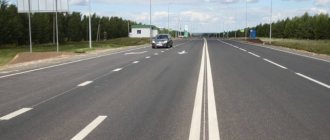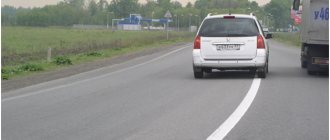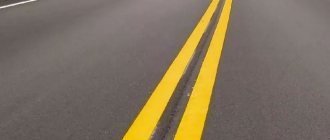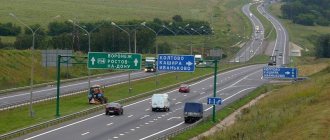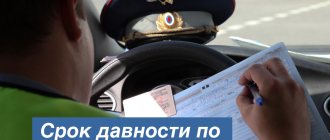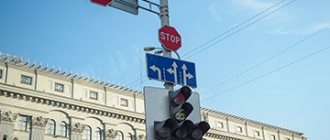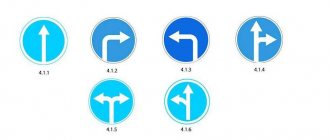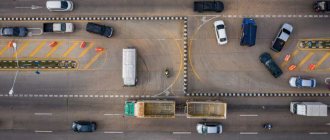Characteristics of double solid line
Traffic regulations of the Russian Federation give the following definition of double continuous 1.3 - this is a horizontal marking consisting of 2 parallel white continuous lines, which always separates oncoming traffic flows. It is used on roads:
- with 4 or more rows;
- with 2 or 3 lanes, each wider than 3.75 m.
From June 2021, bright yellow 1.3 markings may appear on the roads. It is assumed that this color makes the lines more visible in fog and under a layer of snow. Orange markings are considered temporary. It has priority over the others, while white and yellow are equal.
Rules for turning around without violating
Before turning, a signal is given in advance: with a light or, if the turn signals do not work, with a hand. You also need to make sure that the maneuver will not interfere with other road users and will not provoke an accident.
To make a U-turn, drive up to the left edge or occupy the leftmost lane of your direction (on a 3-lane road - the central lane, reserved for driving in both directions). If there are passing tram tracks on the left and there are no markings 1.18 or signs “Moving in lanes” 5.15.1/2, stand on them. They wait until the road is clear of oncoming traffic long enough to maneuver, and only then turn around.
Prohibitions and permissions
There is a certain list of situations that limit vehicle maneuvers. U-turn is prohibited (clause 8.11 of the Russian Traffic Regulations):
- on zebra crossings;
- in tunnels;
- on bridges, viaducts, overpasses, overpasses and under them;
- on railway tracks;
- on sections of the road with poor visibility (less than 100 meters);
- close to minibus and bus stops.
Permitted areas for turning are those where the markings are missing or are applied intermittently. Line 1.11 allows you to perform the maneuver from the intermittent side. On multi-lane roads and intersections, you should also follow signs 5.15.1/2 or markings 1.18 (both show how to move along the lanes. The arrow indicating a turn also allows a U-turn).
On narrow roads and for large vehicles, it is permissible to perform the maneuver starting from the right edge, lane or even from the side of the road. But this should not interfere with other drivers moving in the same direction: they need to be let through.
It is allowed to make a U-turn through a continuous line after signs 6.3.1 and 6.3.2 (a place or area intended for this). Road signs, even temporary ones, take precedence over markings and are valid until the first intersection or until canceled.
How to act according to the law?
Section 9 of the traffic rules sets out the norms for crossing continuous roads. On roads with opposite traffic, where there are several lanes, it is not allowed to drive onto parts of the road intended for oncoming cars.
Turns or U-turns to the left in such areas are carried out at intersections, as well as in those places where the rules allow such actions to be performed in the absence of markings and prohibitory signs.
In what cases is it prohibited to cross?
There are situations in which a motorist is prohibited from crossing solid markings applied to the road surface:
- while driving on a dual carriageway with four or more lanes;
- oncoming movements are divided by a double solid line;
- if there are three lanes on the road, where the middle one is used for driving in both directions;
- when driving at a controlled intersection, in areas with poor visibility and at the end of a hill.
How to turn around without breaking traffic rules?
To make a U-turn without violating traffic rules, you should pay attention to road signs No. 6.3.1 and No. 6.3.2, which indicate the area for a U-turn. In any other place on the road, where there are no prohibiting signs and there are convenient conditions for action, you can make a U-turn.
Penalty for turning around through markings
The penalty is imposed not for crossing a double solid line, but for an incorrectly carried out maneuver. A U-turn not in accordance with traffic rules is punishable under Art. 12.16 Part 2 of the Code of Administrative Offenses of the Russian Federation with a fine of 1–1.5 thousand rubles.
It is important to know! Unlike overtaking, making an illegal turn will not result in the deprivation of your license. The violation in itself is not associated with driving into oncoming traffic: such maneuvers end with a change in direction. The driver does not drive parallel to the traffic flow in someone else's lane, overtaking other cars, but at an angle to it, turning.
The intersection of a double solid line can be recorded by a traffic police inspector and the violator can be stopped. He makes a decision on the spot if the driver does not deny and agrees with the punishment. Otherwise, he draws up a protocol and sends the case materials to the court.
Most often, an incorrect turn is recorded by a video recording device. A special program recognizes a maneuver in the wrong place, determines the license plate number of the car and the owner, and automatically generates a fine (1000 rubles). The motorist receives a copy of it by registered “letter of chain” or notification in the Personal Account on the government services portal.
A fine for crossing a double solid line in 2021 can be paid off with a 50 percent discount. To use it, the driver must pay no later than 21 days after the decision is issued. If the “chain letter” was delivered to the driver later, he has the right to restore the deadline through the court.
If you drive into the oncoming lane
If, when leaving the intersection, you find yourself in the oncoming lane, then in this case you will be punished under Part 4 of Article 12.15 of the Code of Administrative Offenses, which provides for deprivation of your license or a large fine.
It's all about clause 8.6 of the Traffic Rules, which clearly prescribes:
8.6. The turn must be carried out in such a way that when leaving the intersection of roadways the vehicle does not end up on the side of oncoming traffic.
And driving into oncoming traffic where this is prohibited according to traffic regulations, a special administrative norm is provided for - namely Part 4 of Art. 12.15 with the possibility of depriving the driver of his license for 4-6 months or, in the presence of mitigating circumstances, imposing a fine of 5,000 rubles.
We are talking about this maneuver:
And with such a hook (double) continuous when turning left, the liability that falls under the deprivation of rights, unfortunately, is severe, but legal.
If there was no marking
In this case, according to traffic regulations, you are required to divide the road into 2 halves in the longitudinal direction - the left half will be the oncoming lane.
Thus, if, when leaving the intersection when turning left, you find yourself (partially) on the left half, then in this case, too, the inspector, imputing part 4 of Article 12.15 of the Administrative Code, will be right.
How to determine the middle of the road in order to divide the passing and oncoming directions? Alas, to the eye! Just take a sure reserve when maneuvering, only this will help avoid problems. And, of course, you should always drive with the DVR turned on.
I caught the solid one only with the wheel
Yes, even if you didn’t drive on solid wheels at all, but simply drove out with the dimensions, then according to the practice of 2021, an offense will be considered against you.
The point here is the very principle of road safety. Obviously, paragraph 8.6 of the traffic rules was created to avoid colliding with oncoming cars when leaving the intersection. And it cannot be said that the collision could have been avoided if you crossed a solid line with just a wheel. Even if any large part of the car gets into oncoming traffic, an accident may occur with vehicles that are standing or driving in this oncoming lane (in relation to you) on completely legal grounds.
Will there be a deprivation or a fine?
When a driver is charged under Part 4 of Article 12.15 of the Code of Administrative Offences, a case is only initiated on the road: a protocol is drawn up, and then it is passed on to another employee - the case is considered by the head of the traffic police at the location of the violation. There are two possible results of consideration by this department:
- for crossing a solid road when leaving an intersection, a fine of 5,000 rubles will be issued,
- if the employee decides that the driver should be deprived of his license, then he sends the case materials to the court, since the traffic police are not authorized to deprive a driver’s license.
The court is already deciding again whether to impose a fine or imprisonment.
But what exactly will happen in your case depends on mitigating and aggravating circumstances, the list of which is exhaustively listed in Articles 4.2 and 4.3 of the Administrative Code, respectively.
But there is another unwritten factor that both inspectors and judges are certainly guided by - whether you have had fines for the last year. If they exist (even paid and even for other violations), then the likelihood of further deprivation of rights as a more severe punishment increases (it is not yet 100% - everything is at the discretion of the judge).
Additional penalties for repeated violations
A repeated violation is considered to be committed within a year after the fine for the previous one has been paid. The Code of Administrative Offenses of the Russian Federation does not provide for any special punishment for the second or subsequent turns through a double solid line. “Repeat offenders” face the same fine of 1000–1500 rubles.
Attention! Unlike making a U-turn, for repeated overtaking by crossing marking 1.3 and driving in the oncoming lane, the driver will be deprived of his driving privileges for a year (12.15 Part 5 of the Code of Administrative Offenses). If this is caught on camera, the offender will get off with a fine of 5 thousand rubles.
Penalty for crossing
Not so long ago, any maneuver that resulted in crossing a solid line was considered to be a vehicle entering a lane that was prohibited for that direction. Then the situation changed somewhat. Now the law more clearly defines which types of crossing markings are punishable by a fine, and for which the driver is deprived of his license.
When turning left
By crossing solid markings when turning left, a motorist risks being punished in accordance with Article 12.15 of the Code of Administrative Offenses (Part 4). The maneuver is qualified as driving into oncoming traffic and is punishable by an administrative fine of 5,000 rubles. A decision may be made to deprive the person of the right to drive a vehicle for 4-6 months. When driving, the turning trajectory is of great importance.
If a car making a left turn through a solid road travels along a slanted path, it will certainly end up on the left side of the oncoming lane. If the need to make a turn in this particular place is great, the only thing that can be recommended is to cross the road at a right angle. This will reduce the size of the punishment - it will be established according to Article 12.16 of the Code of Administrative Offenses and is expressed in a fine of 1000-1500 rubles.
When turning right
If a motorist turns right, ignoring the solid line marked on the road surface, the driver will be fined 1000-1500 rubles for violating the marking requirements. If the circumstances of the case are examined separately, the punishment may be an administrative fine in the amount of 500 rubles (Article 12.14 of the Administrative Code).
The act can be qualified as failure to comply with the requirements prescribed by road signs or road markings. When making a right turn, crossing a solid road can be done with impunity if a broken down vehicle with the hazard lights on is stopped in the right lane. In this case, the maneuver is classified as forced.
Through double
U-turns and turns made while crossing a double marking line are punishable under Art. 12.16 Code of Administrative Offences, part 2. The penalty when turning will be 1000-1500 rudders.
In which case there will be no fine
There are 2 circumstances in which a fine can be avoided for a U-turn crossing a double solid line in 2021:
- the insignificance of the violation;
- extreme necessity.
The provision on insignificance (Article 2.9 of the Code of Administrative Offenses) in relation to the fine for a double continuous line in 2021 is used extremely rarely. To do this, it is necessary that the case contains a maximum number of mitigating circumstances and a minimum number of aggravating ones.
The offense must not be repeated, committed during an emergency or natural disaster. Mitigating circumstances include the repentance of the offender, the commission of an offense by a pregnant woman or a novice driver, the actual absence of harm caused, etc. Minority can be applied, for example, if the violation occurred on a deserted road outside the city.
Under extreme necessity (Article 2.7 of the Code of Administrative Offenses of the Russian Federation) we understand the commission of an offense under emergency circumstances to prevent greater harm. This could be some kind of danger that threatened the driver, passenger or other traffic participant, which could not be avoided by other means. It is not easy to prove extreme necessity, but Art. 2.7 is used more often than 2.9 of the Administrative Code.
When turning left, the driver crossed a double line
When turning left, the driver crossed a double line
Requalification from Part 4 of Art. 12.15 on part 2 art. 12.16 Code of Administrative Offenses
P4a-602/16
P O S T A N O V L E N I E
<data taken>
<data withdrawn> April 18, 2021
Deputy Chairman of the Moscow Regional Court ..., having considered the complaint ... against the decision of the magistrate ... judicial district of the Serpukhov judicial district <data taken> from <data taken> and the decision of the Serpukhov City Court <data taken> from <data taken> in the case of administrative offense provided for in Part 4 of Article 12.15 of the Code of Administrative Offenses of the Russian Federation in relation to ...,
U S T A N O V I L:
By the decision of the magistrate ... the judicial district of the Serpukhov judicial district <data withdrawn> from <data withdrawn>
..., <data taken> year of birth, native of <data taken>, living at the address: <data taken>,
found guilty of committing an administrative offense under Part 4 of Article 12.15 of the Code of the Russian Federation on Administrative Offenses, and he was given an administrative penalty in the form of an administrative fine in the amount of 5,000 rubles.
By the decision of the Serpukhov City Court <data withdrawn> from <data withdrawn> the decision of the magistrate was left unchanged.
In a complaint filed in accordance with Articles 30.12-30.14 of the Code of Administrative Offenses of the Russian Federation, ... asks to cancel court decisions and terminate the proceedings due to the absence of an administrative offense in his actions. Refers to the fact that the courts of two instances, when considering the case, violated the norms of substantive and procedural law.
Having checked the correct application of the rules of substantive and procedural law in the case, based on its materials and the arguments of the complaint, I come to the following conclusion.
The courts of two instances established that the driver ... <data taken> in ... on <data taken> while driving a vehicle..., followed <data taken> towards <data taken>, at building 1824, entered the lane, intended for oncoming traffic, with the intersection of the double solid marking line 1.3 of Appendix N 2 of the Russian Federation Traffic Regulations, thereby violating clause 1.3 of the Russian Federation Traffic Regulations.
Responsibility provided for in Part 4 of Art. 12.15 of the Code of Administrative Offenses of the Russian Federation, occurs in the event of driving in violation of traffic rules into a lane intended for oncoming traffic, or onto tram tracks in the opposite direction, except for the cases provided for in Part 3 of this article.
Horizontal markings (lines, arrows, inscriptions and other markings on the roadway) establish certain modes and order of movement.
According to Appendix 2 to the Traffic Rules of the Russian Federation, approved by Resolution of the Council of Ministers - Government of the Russian Federation No. 1090, horizontal markings 1.3 separate traffic flows in opposite directions on roads with four lanes or more.
To confirm guilt... of committing an offense, the courts referred to the administrative violation protocol, photo table, and marking location diagram.
At the same time, the fact of committing... an administrative offense under Part 4 of Art. 12.15 of the Code of Administrative Offenses of the Russian Federation, is not confirmed by the totality of evidence available in the case materials.
From the protocol on the administrative offense it is seen that the guilt ... is charged with violating the requirements of markings 1.3 of the Traffic Regulations of the Russian Federation separating traffic flows in opposite directions when turning left, since following the <data taken> from <data taken> there is a turn to the left.
So from the photographs it can be seen that ... made a left turn crossing marking 1.3 of Appendix No. 2 of the Russian Traffic Regulations, without reaching the intersection. Under such circumstances, the conclusion of guilt ... of committing an administrative offense under Part 4 of Art. 12.15 of the Code of Administrative Offenses of the Russian Federation is unfounded.
By virtue of the provisions of Part 1 of Art. 1.5 of the Code of Administrative Offenses of the Russian Federation, a person is subject to administrative liability only for those administrative offenses in respect of which his guilt has been established.
Clause 1.3 of the Traffic Rules of the Russian Federation stipulates that road users are required to know and comply with the requirements of the Rules, traffic lights, signs and markings related to them.
When making a left turn maneuver on a two-way road with four or more lanes, crossing the double solid marking line 1.3 of Appendix No. 2 of the Traffic Regulations of the Russian Federation ... did not commit an administrative offense under Part 4 of Art. 12.15 Code of Administrative Offenses of the Russian Federation.
Crossing the road marking line 1.3, when turning left, he violated the road marking requirements. Under such circumstances, the actions ... contain signs of an administrative offense under Part 2 of Art. 12.16 of the Code of Administrative Offenses of the Russian Federation, namely, turning left in violation of the requirements prescribed by the markings of the roadway.
According to the Resolution of the Plenum of the Supreme Court of the Russian Federation dated <data taken> N 18 “On some issues that arise for courts when applying the Special Part of the Code of the Russian Federation on Administrative Offences”, the driver’s actions related to turning left or making a U-turn in violation of the requirements of road signs or markings constitute the objective side of the administrative offense provided for in Part 2 of Article 12.16 of the Code of Administrative Offenses of the Russian Federation. For example, violation by the driver, when carrying out these maneuvers, of the requirements prescribed by: markings 1.1, 1.3, 1.11, 1.18; road signs 4.1.1 “Moving straight”, 4.1.2 “Moving right”, 4.1.4 “Moving straight or right”, 3.18.2 “Turning left is prohibited”, 3.19 “Turning is prohibited”, 5.15.1 “Driving directions along lanes", 5.15.2 "Directions of movement along the lane", 6.3.1 "Place for a turn", 6.3.2 "Area for a turn".
From the case materials it follows that the driver... <data taken> at 10:55 am at <data taken> while driving a vehicle....followed along <data taken> towards <data taken>, near building 1824, when turning to the left, crossed the double solid marking line 1.3 of Appendix N 2 of the Russian Traffic Regulations.
In his explanations during the trial ... indicated that he made a left turn at the intersection <data taken>.
In paragraph 20 of the Resolution of the Plenum of the Supreme Court of the Russian Federation dated <data taken> N 5 (as amended from <data taken> N 23) “On some issues that arise for courts when applying the Code of the Russian Federation on Administrative Offenses” it is stated that if During the consideration of the case, it is established that the protocol on an administrative offense contains an incorrect classification of the offense committed, the judge may reclassify the actions (inaction) of the person to another article, which provides for the elements of the offense, having a single generic object of encroachment.
In accordance with Part 2 of Art. 12.16 of the Code of Administrative Offenses, turning left or making a U-turn in violation of the requirements prescribed by road signs or markings of the roadway - entails the imposition of an administrative fine in the amount of one thousand to one thousand five hundred rubles.
This norm has a single generic object and, in terms of punishment, improves the position of the person subject to administrative liability, since the sanction of Part 2 of Art. 12.16 is softer than the sanctions of Part 4 of Art. 12.15 Code of Administrative Offenses of the Russian Federation.
Under such circumstances, the contested decision of the magistrate and the subsequent decision of the city court are subject to change in terms of qualification of the offense committed by him from Part 4 of Art. 12.15 Code of Administrative Offenses of the Russian Federation on Part 2 of Art. 12.16 Code of Administrative Offenses of the Russian Federation.
Taking into account the circumstances and nature of the administrative offense committed, personal data ..., and also taking into account Art. Art. 3.1, 3.5 and 4.1 of the Code of Administrative Offenses of the Russian Federation, I believe it is possible to assign ... y, within the sanction of Part 2 of Art. 12.16 of the Code of Administrative Offenses of the Russian Federation, administrative punishment in the form of an administrative fine in the amount of 1000 rubles.
Based on the above, and guided by clause 2, part 2, art. 30.17 Code of Administrative Offenses of the Russian Federation,
P O S T A N O V I L :
resolution of the magistrate ... judicial district of the Serpukhov judicial district <data taken> from <data taken> and the decision of the Serpukhov City Court <data taken> from <data taken> in the case of an administrative offense under Part 4 of Article 12.15 of the Administrative Code RF in relation to..., change.
Reclassify the administrative offense committed ..., from Part 4 of Art. 12.15 Code of Administrative Offenses of the Russian Federation on Part 2 of Art. 12.16 Code of Administrative Offenses of the Russian Federation.
Find... guilty of committing an administrative offense under Part 2 of Art. 12.16 of the Code of Administrative Offenses of the Russian Federation, and impose an administrative penalty on him in the form of an administrative fine in the amount of 1000 rubles.
The rest of the decision of the magistrate ... judicial district of the Serpukhov judicial district <data taken> from <data taken> and the decision of the Serpukhov City Court <data taken> from <data taken>. leave unchanged.
Deputy Chairman of the Court...
Is it possible to appeal the decision?
To protest prosecution under Art. 12.16 Part 2 of the Code of Administrative Offenses, the driver files a complaint addressed to the head of the traffic police department or to the court. It may refer to the following circumstances:
- The turn across the dividing line was recorded by a camera and the order was issued to the owner of the car, although the real offender was another driver.
- The traffic police inspector did not act according to regulations and made procedural errors that may cast doubt on the guilt of the motorist. This could be, for example, recording a reversal on a non-certified camera. Video from this device has no evidentiary value.
- The markings were not made according to the rules. The new GOST R 51256-2018 dated February 20, 2018 did not change the requirements for double solid. The width of its parallel lines should be 0.1, 0.15 or 0.2 meters, the distance between them should be 0.1–0.18 m. Markings with such parameters are clearly visible, and do not take up much space on the roadway. If applied not in accordance with GOST, it is equivalent to being absent. True, the court is unlikely to accept evidence other than the examination.
- The markings are hidden under a layer of snow, water or mud. It is not so much the driver who is to blame for the violation, but rather the utility services. As evidence of this, you need to provide video recordings, photographs from the turning point, and witness statements.
It is important to know! Not all traffic police inspectors correctly qualify the actions of the driver. Sometimes even traffic cameras make mistakes.
Most often, for a detour, a U-turn or a turn through a double solid line, instead of a fine in 2021, you are deprived of your rights, that is, the provisions of Art. 12.15 h. 4 Code of Administrative Offenses - driving in the oncoming lane. In such cases, the courts mostly side with the drivers, changing their punishment.
Crossing a solid road when turning left - a violation or not?
Yes, in all cases, this will be a violation, but the degree of punishment depends on the purpose of the marking lines.
- If a solid line divides the roadway into several lanes, you may be fined 500 rubles.
- If a line separates opposite lanes of traffic after passing through an intersection, and you hit it, then you may be deprived of your license.
The first measure is applied only for violation of markings, according to Art. 12.16 p.1. In this case, there is a change of lane from one lane to another, violating the Rules. But here the oncoming lane does not matter, as does the left turn at the intersection. Failure to comply with the markings occurred after this maneuver.
As shown in this picture, the green car has crossed the solid line dividing the passing lanes. But what punishment awaits the driver if he crosses a solid double lane and ends up in oncoming traffic?

